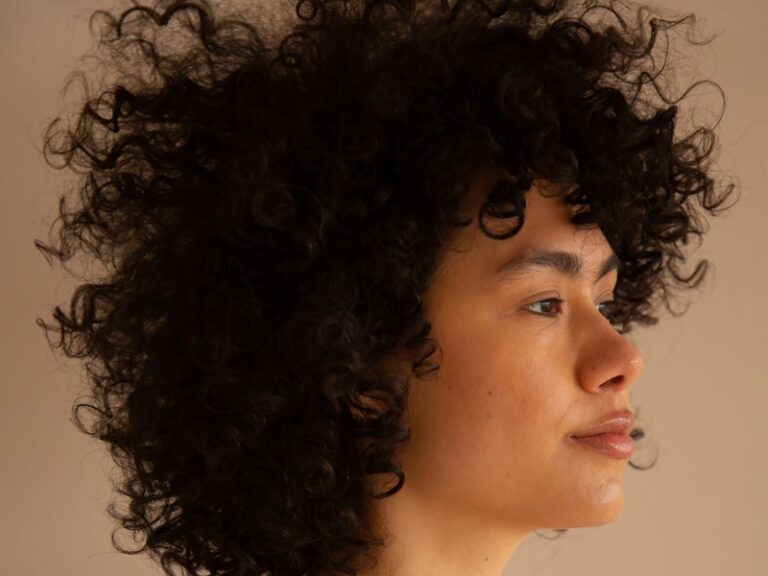Contents
The journey of growing curly hair is, quite simply, a longer one than that of straight. That's because you can't see growth nearly as much as you can for straight hair, given the twists and turns that curls take. Additionally, curly hair is more prone to breakage, so even if you have grown some length on your curls, you don't always get to keep it indefinitely.
To get to the bottom of how to grow curly hair, we spoke with two natural haircare specialists: Annajid "Kee" Taylor and Darrius Peace. Read on for their tips and tricks for keeping curly hair healthy, breakage-free, and growing.
Moisturize Frequently
You’ll thwart your growth attempts if your hair breaks, and moisturizing is key to not letting that happen. “Keeping curly hair well-moisturized is crucial to preventing breakage,” explains Taylor. “Regular deep conditioning treatments can help maintain hydration and strengthen the hair.” Peace seconds this: “Frequent conditioning, along with little to no heat treatments, can also aid in [preventing] breakage,” he says.
Detangle Properly
There's no getting around the need to detangle curly hair, but how, when, and what you use matters greatly. Peace says water, conditioner, and a detangling brush are the power trio for removing tangles and facilitating growth, and Taylor agrees. "These tools are designed to glide through the hair with minimal breakage and pulling," she says.
You want your hair to be wet and saturated in conditioner "to provide slip and make it easier to work through knots," says Taylor. Then, "start detangling from the ends of your hair and gradually work your way up to the roots to prevent breakage and reduce stress."
Keep It Hydrated
Moisture is all about the outside of your hair being coated and protected, while hydration refers to the inside of your strands not drying out. Both are important to facilitate growth and prevent breakage, and you can sometimes find products that perform both functions. “Creamy conditioners applied on wet hair are [the] most ideal for retaining hydration and moisture,” advises Peace.
Trim Regularly
Cutting your hair when growth is the goal might sound counterintuitive, but there’s no getting around the fact that trimming is necessary on occasion. It’s an indirect help: Peace explains that “although trimming does not help the hair grow, it does give the hair a more polished appearance while also making it easier [to comb and brush].” Easier combing and brushing leads to better retention of new growth. Plus, “by removing split ends, trims prevent breakage and damage from spreading up the hair shaft,” adds Taylor. “This helps hair retain its length and look fuller and healthier, giving the appearance of better growth over time.”
Click here to preview your posts with PRO themes ››
Don't Forget Diet
"The best products for hair growth are the foods we put in our mouth," says Peace. "Most topical solutions aid in the retention of hair growth." He adds that deficiencies ranging from protein to fresh produce to sufficient hydration can all keep your hair from growing well.
“Your hair needs specific nutrients to grow strong and healthy, such as protein, which is essential for keratin production,” explains Taylor. “Vitamins A, C, and E support scalp health and blood circulation, and biotin is essential for hair loss… including these vitamins and nutrients in your diet and staying hydrated can significantly contribute to healthier and improved hair growth.”
Oil Up
Most curly-haired folks are well acquainted with hair oils for adding shine and smoothing—and as it turns out, some can even aid in hair growth. Taylor loves castor and rosemary oils, specifically: “Castor oil is rich in fatty acids and vitamin E, strengthening hair and supporting healthy growth. I particularly love using Jamaican black castor oil while wearing my hair in a protective style to promote hydration and overall hair health.” As for rosemary oil, she says it “stimulates blood circulation to the scalp, promoting hair growth and reducing hair loss.”
Peace says the culinary oils in our kitchen cabinets can also help. “Olive oil and grapeseed oil are excellent products for retaining hair growth,” he tells us.
Be Gentle
No matter what tools or techniques you use on your hair, it's important to remember to use a gentle hand. "Curly hair tends to be drier and more fragile, making it prone to snapping," says Taylor.
Because your hair is most vulnerable when wet, it's vital to take even more care when handling it in that state. Develop healthy habits that help you slow down when dealing with your curls; for example, Taylor suggests detangling from the ends of your hair and working your way up, instead of starting from the top (like you might with straight hair).
Protect, Protect, Protect
Curly hair benefits greatly from protection. “Protective styles, like braids or twists, can reduce breakage by minimizing friction,” says Taylor. Additionally, “sleeping with a silk or satin pillowcase or bonnet can also be beneficial,” along with avoiding heat styling whenever possible—and using a heat protectant when you can’t—and drying your hair with a microfiber towel.
The Final Takeaway
Hair growth for curly hair needs to be approached from multiple angles, including keeping your hair well-protected, moisturized, and hydrated, eating the right nutrients to enable your hair to grow, and being gentle with tools, products, and handling. Even though it takes longer to see growth because of the bendy nature of curly hair, it will happen. The more you prevent breakage—which these tips from our stylists can help you do—the faster you'll see those desired results.


